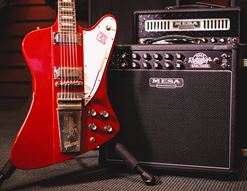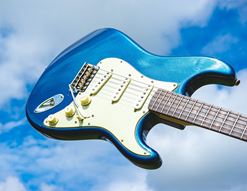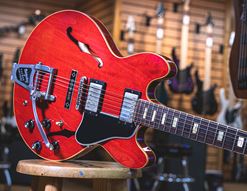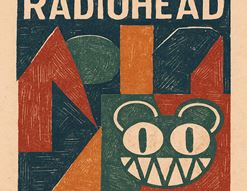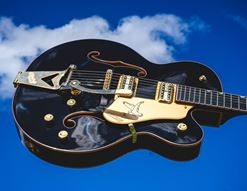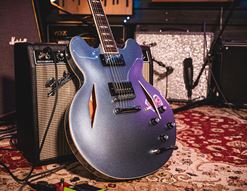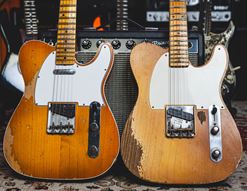What’s your favourite flavour of rock?
We all love rock music. It’s the glue that holds our collective musical souls together, whether it be rock music from right now or from 60 years ago.
But what is rock music? It’s changed a lot in its many decades of existence, and has branched out in a number of directions. At times, it’s hard to distil what exactly rock music ‘is’ - at least compared with some pop and some metal - but we all love a good sub-genre, don’t we? As music fans, we like to really turn the dial on the microscope and zoom in to the music we love. It’s not enough to be a rock fan: we must be a punk rock fan, or a goth, or whatever else.
These sub-genres can actually niche down even more, but today is about covering as wide a landscape as I can, within a reasonable ‘rock’ frame. I’m not going to delve into the metal subgenres, because I’ve already done that: have a click through to the Metal Subgenres blog for the lowdown on ‘the heavier stuff’. But for everything from Indie rock to post rock, keep on reading!
How hard do you rock?
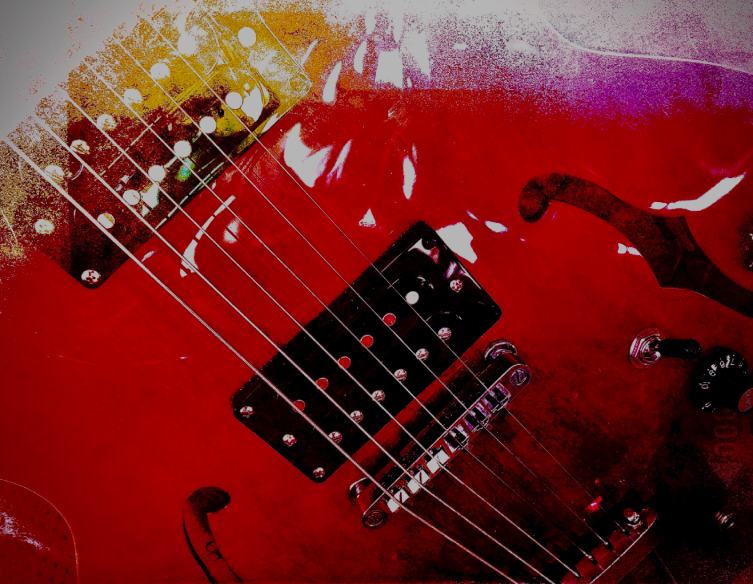
Contents
Rock Music: The Lines are Blurred
Classic Rock
Classic rock is what used to just be called ‘rock music’ back in the day. Those were simpler times, when those who were about to rock were saluted, before the levee broke etc etc. There are riffs, there are solos and there are melodies; there is bluster, there is swagger, and there will be lots of posturing. Loud grooves meet heroic guitars and singers who are goldlike in their immensity.
The band that comes to mind straight away is Led Zeppelin, followed by AC/DC, Queen, Aerosmith, Deep Purple and those kinds of bands.
It’s funny, but rock gets less heavy as it ages. This is likely the result of newer music pushing boundaries of intensity, but Led Zep and AC/DC used to be referred to as heavy metal, which feels ridiculous to me! They rock hard, but not necessarily heavy. It’s a fine line!
For example, I wouldn’t include Black Sabbath on this list at all, because I’d say they are metal, not rock or classic rock. Would you agree?
Pop Rock
Pop rock is when pop tunes have crunchy guitars and maybe even a solo, depending on the decade. A great example of pop rock is Bon Jovi, and anything like that. These songs are often big anthems with sky-high choruses, hooks aplenty and an immediacy of access.
Avril Lavigne is a good example of pop-rock, however much she may dress it up as punk rock: we are not convinced! Her songs are catchy and she has a wide audience, which pretty much defines the genre as it was in the late 90s the way Livin’ on a Prayer did in the mid 80s.
Going back to the heyday of the 70s, something like More Than A Feeling by Boston is probably one of the best examples of pop rock: it does rock, but it’s a song that everyone can sing and it was all over the radio. Huge tunes!
Soft Rock
Heart, Fleetwood Mac, Squeeze and bands that look and act somewhat like rock stars on stage but don’t cause any worry for parents: these are your soft rockers. They want to come across as a rock band but are maybe too polite to raise their voice about it.
Somehow, soft rock is different than pop rock. Pop rock can actually rock pretty hard (Foo Fighters), but it’s the accessible melodies and tempo that make it ‘pop’. Soft rock often isn’t as instantly attention-grabbing as pop rock, but that depends on the artist (Wishbone Ash). ‘AOR’ is a type of soft rock, and stands for Album Oriented Rock. This is where you’d file the likes of Toto and so on: slick stuff that’s perfectly nice and has zero bite.
Soft rock can appear in other genres, since it’s the easy palatability that defines it more than anything else: Travis and Coldplay, for example, are indie rock bands but also as soft as it gets. ‘Soft’ isn’t bad, by the way, but it’s not very ‘rock’ either, is it?
That said, you could easily call The Eagles soft rock too, and they at least behaved like proper rock stars. But were they also folk rock? See below!
Folk Rock
Did Bob Dylan invent folk rock when he ‘went electric’, or did it exist already? I feel like Dylan’s attitude made him a folk rock star regardless of what guitar he strummed on. Folk rock was a scene that had various hotspots in the US: if Greenwich village in New York was where folk was strictly acoustic and unplugged, then Laurel Canyon in Los Angeles was where those songs met an almost psychedelic palette of electric blues and rock. Classic rock? Definitely, but in a pretty distinct ‘folky’ shade: Joni Mitchell, CSN&Y, Jackson Browne and loads of other musicians armed with Martin acoustics defined a scene that slowly turned into something much more luxurious and insipid, but the greatness of the initial period is obvious.
The Eagles came out of this scene, but I’d actually say that The Band - made up mostly of Canadians - are the true originators of the folk rock sound. They were genuinely innovative trailblazers, and after all, it was them on stage with Dylan when he was accused of being Judas for playing a Strat!
The UK had a folk rock scene too, and an influential one at that: Fairport Convention and Pentangle were amongst those who created the ‘Canterbury Scene’, which developed in ever-more proggy and psychedelic ways.
Psychedelic Rock
Coming out of the folk rock scene and into the prog and psychedelic scenes were where slightly more esoterically-minded musicians went. From the Canterbury folk scene in England, the Haight-Ashbury Hippie scene in San Francisco to Deia in Majorca, musicians looking for the road somewhat less travelled took their folk influences, mixed it with Hendrix and acid, and went off on their own inner journeys through the constellations.
Psychedelic rock has a strong lineage in the UK that’s quite unrelated to the famous Californian scene. Musicians attending the ‘free festivals’ in places like Stonehenge cultivated a significant musical heritage that brought us Hawkwind, Crass, Gong and Ozric Tentacles.
In America, you had Love, you had The Doors and you had Jefferson Airplane. All of this made it’s way past Charles Manson and David Geffen to find a new psychedelia with bands like The Mars Volta decades later.
Glam Rock
Glam rock connotes images in one’s mind as much as it does sounds: say the words ‘glam rock’ to yourself and just try not to think of Ziggy Stardust, Marc Bolan or Brian Ferry with a feather boa round his neck! It’s a fabulous, subversive take on the macho cliches of the 70s ‘rock god’, whilst simultaneously celebrating all of that stuff as well.
Glam rock does have a particular sound, though, and I’d say that it is summed up as much on the Rocky Horror Picture Show’s soundtrack as it is by the Aladdin Sane album. The guitars are scuzzy, there are pianos aplenty and everything sounds like it’s covered in glitter. Decadent, ornamental, revelling in melodrama and deliberately seeking to push cultural boundaries about gender and sexuality, glam rock is a sound and vibe that never quite sounds ‘now’, nor does it ever truly age: it exists happily in its own ‘otherness’.
Hard Rock
When is rock too hard to be ‘classic’ but not hard enough to be metal? Good question, but I’d suggest that - at least back in the day - Guns n Roses would fall into this category quite nicely. Because rock music in general has ripped off the blues so much (more in a second), it’s quite fair to call the likes of GnR ‘blues rock’ and ‘classic rock’ too, but they do push their sound a bit harder than folk like Aerosmith, hence the ‘Hard Rock’ monicker.
Context is everything of course: Grunge (see somewhere below) is essentially hard rock corralled into one geographical location and time. Stone Temple Pilots, then, could be called a definitive hard rock band, since their San Diego location precludes them from being a true grunge band in the eyes of the rock snobs. They certainly rocked harder than Boston, for example, so the hard rock tag works for me!
Hard rock is a difficult one to single out from other genres: Led Zep are hard rock, but they are also classic rock; the same is true of Van Halen. I think it’s safe to say that if it’s not quite pushing into ‘metal’ territory, a lot of the music on this list of subgenres could be happily labelled ‘hard rock’, so I’m sticking with Slash and Axl!
Blues Rock
Blues rock is what happened when electrified blues music got popular and started being imitated by musicians from other countries. If the blues is an American tradition (from an African source), then it’s possibly true to say that the blues rock genre was first mastered by the British (during their ‘Invasion’ in the 60s) before being picked up again by the Americans.
I suppose an archetypical blues rock band would be the Rolling Stones. They developed this hybrid genre alongside the likes of Clapton, Beck, Kossoff etc, but the Stones endured as a band and made that sound into a musical language that was accepted universally.
There is a never-ending procession of blues rock artists out there nowadays, and they are mostly white males who sing and play guitar. Lots of your favourite guitarists fall into this idiom, from Eric Clapton and Gary Moore to Joe Bonamassa and Stevie Ray Vaughan. Because the musical form itself is easy to pick up and put one’s own stamp on, it’s one of the most popular styles for guitarists to play.
Southern Rock
Southern Rock nowadays describes a flavour of classic rock that gets most of its inspiration from Lynyrd Skynyrd and the Allman Brothers Band.
You can tell a Southern rock band straight away by looking at them, so ingrained is the look: long hair, beards, cowboy hats, cowboy boots…actually, these bands just dress up entirely like cowboys, but the type of cowboys who hang out in biker bars playing pool rather than riding horses and corralling cows.
Musically, Southern rock is very blues based, and favours long instrumental passages with guitar - and often keyboard/organ - solos aplenty. It’s rock music from the Southern states of the USA, and regional accents definitely help to add to the authenticity. As an unspoken rule, there can be nothing musical from the 80s onwards included, so the guitars have to sound like British Invasion guitars and the keys need to be organs. There cannot be even a hint of a computer involved.
The grooves are straight forward but designed for shaking one’s ass too, and whilst there can sometimes be a slight Country influence, it’s implied more through the vocals (and outfits) than anything instrumental. You could say that Southern Rock is adjacent to Americana, which is, I suppose, mid way between country, Bluegrass and folk.
Prog Rock
Short for ‘Progressive’, prog rock is a term that’s pretty accurate but for some reason, lots of artists don’t want to be associated with it. In the 70s, bands like Pink Floyd, King Crimson, Genesis and Yes defined prog with their labyrinthine epics that merged rock music with jazz and classical, evoking other planets with their cosmic flights of fantasy.
Prog albums sometimes only had three pieces of music for the entire record, and the songs would contain ‘movements’ that each had their own sound and parts. After a while, some came to view this as unacceptably excessive, and then punk came along and unceremoniously drew a line under the Moog solos and cape-wearing.
Since then, bands like Marillion and Porcupine Tree have resurrected the genre, creating subsequent generations of prog that have incorporated other influences, but the main idea of having larger, longer suites of music that ‘progress’ into different areas remains fundamental.
Punk Rock
Punk was a massive watershed moment in modern music. In one brash explosion of energy and intent, punk swept away the gatekeepers of technical, elaborate music (from Led Zeppelin to Yes, and including all bands in between) and showed by example that anybody could be in a rock band. Well, anybody who was under 23 years old and angry, preferably with a London-ish accent.
Anyway, punk was certainly an important galvanising period in music, and whilst I tend to think of punk in british terms - the Sex Pistols and the Clash - I suppose I have to concede that the Ramones and New York Dolls were not only leading the way already, but were arguably more subversive in terms of their message and delivery.
Still, punk told the world that you were gonna do things your way and if the world didn’t like it, well, the world could just shove it! Like all things, it became a commodified genre full of posers and copycats, but that always happens. The original fire is ever-inspiring, and the bands that truly understood the message went on to colour-in the New Wave scene that followed immediately in both London and New York (and everywhere else too, where there were no music magazines!)
Post-Punk/New Wave
Punk was a moment in time that changed everything, but Post-punk or New Wave were the moments that followed and maybe even left more of a musical legacy.
As ever, we have both sides of the Atlantic to contend with, so for every Talking Heads or Devo in the US, there was a Killing Joke or Joy Division to counter with from over here in the UK. The early 80s were actually a very colourful and fertile ground for bands who’d formed in the ashes of punk, and, delightfully, they all splintered off into their own unique directions.
Post Punk seems, like I mention below with the (very similar) Goth rock subgenre, to be focussed on the dancefloor, with music that is deliberately angular and motorik. There aren’t big guitar riffs or solos, but there are prominent basslines and collages of sound that are both inspired by, and a response to, punk music. From punk to early indie, post-punk/New Wave was the period in between, created by artists and fashionistas as much as by musicians. It’s Blondie, it’s New Order, it’s The Chameleons and it’s a whole lot more too: it’s almost like punk spirit but with more ambition and the odd synthesizer included here and there!
Goth Rock
Goth rock is a funny thing: everybody knows what a cliched ‘goth’ looks like - black clothes, elaborate makeup, dyed black hair and an air of permeable tragedy - but not so many people can pinpoint a definitive goth rock sound. Whilst I could (and shall) list a number of bands that are all beloved by the goth scene, none of them sound particularly alike. In truth, it seems to me that ‘goth music’ is actually just ‘alternative rock’ from the period that came right after punk. Have a look at this lot:
- The Cure
- Bauhaus
- Joy Division
- Siouxsie and the Banshees
- Dead Can Dance
- Sisters of Mercy
See what I mean? There’s nothing much to connect then, apart from a preference for some darker visual imagery. At a push, you could say that there’s a ‘dancier’ vibe here than with, say, 70s rock, and there’s less machismo involved, but I think that goth rock seems to be more about a scene than a sound. Still, every band on that list is absolutely brilliant, so just touch up your eyeliner and get back onto the dancefloor, okay?
Indie Rock
Indie rock has different connotations depending, as ever, on which side of the Atlantic we focus on, and indeed the time in which the music was created.
Indie rock, it seems to me at least, was developed in the 80s. In the US, bands like R.E.M. and Sonic Youth became popular on the newly-created college radio scene, which is literally what you think it was: radio stations at colleges and universities, who catered to their own young fanbase with music that was often local and unsigned. This is where Indie got its name - Independent.
In the UK, it was more about the music press championing bands like the Smiths, who had a similarly retro-jangly sound to R.E.M. and a similar eschewing of the rock ‘dinosaur’ cliches of the 70s.
Indie has progressed into endless permutations of the term today, but I suppose one factor that unites them is a more self-consciously ‘literate’ perspective that concerns itself more with affairs of the heart and emotions than with classic rock’s more ‘below the waist’ fixations.
Britpop
Britpop was a half-decade’s worth of music headlines in the mid 90s spurred on by phoney wars between Blur, Oasis, Suede, Elastica and other headline-seeking indie bands.
The Britpop scene was a look back at a semi-fictional ‘Swinging London’ of the 60s, and updating that for a 90s audience who’d already become familiar with The Smiths and the Stone Roses.
Bands all had Monkees hairstyles, pretended to love The Kinks and dressed like they all shopped in Carnaby Street via a time machine. There were lots of great bands who were swept up into this cultural whirlwind by dint of simply existing at that time (Pulp, Suede, Longpigs, Super Furry Animals etc) and there were some bands who definitely benefited from having the correct look for the moment, if not the tunes (Menswear, Heavy Stereo) but there’s no denying the impact that Britpop had, not only in the UK but across the world.
Math Rock
Math rock, a term that is off-putting to some, is a sort of indie take on the more complicated parts of prog rock, updated and recontextualised for a post-Nirvava audience.
Math rock concerns itself with polyrhythms, unusual time signatures and complex patterns, and it seems that this is the main focus of the music, rather than an incidental or supporting part of it. The genre’s indie sensibility tends to bring math rock away from standard rock posing, but replaces it with its own almost ironic sense of ego. It’s less expansive than prog, and more succinct, too. There are as often vocals present as there aren’t, but there are always dextrous displays of self-consciously complex technique involved. Slint were a major player in this genre, as were Don Caballero and Fall of Troy.
Grunge
If punk came song and swept away the excess of seventies rock and prog, so grunge did the same with hair metal and AOR vanilla soft rock. Bringing angst and darkness to a brand of rock that blended seventies hard rock riffing with 80s DIY indie, grunge exploded from Seattle in the very late 80s, dominating guitar music for a good half-decade.
Heroin, rain and hopelessness were all built into the so-called ‘Seattle sound’, with a raw realness that made bands like Skid Row and Poison look immediately ridiculous and hopelessly out of date.
Nirvana are often the most-cited grunge band because they were easily the biggest, but I’d say that they are perhaps not the best indicator of the Seattle sound, since there’s was actually a quite simple and uncomplicated sound with little to none of the grunge hallmarks displayed by the other titans of the genre.
So, who would the defining grunge bands be? I’d go with these:
- Alice in Chains
- Pearl Jam
- Soundgarden
- Mother Love Bone
- Mudhoney
After Grunge, there were a raft of pretty terrible post-Grunge bands around like Bush, Candlebox and all the rest, before blandness resumed with the likes of Counting Crows and the Dave Matthews Band. These were all sent scurrying when Nu Metal showed up, but that’s a story for another day!
Shoegaze
Shoegaze is an offshoot of indie rock that makes much more of a ‘thing’ out of effects-laden guitars. The genre got its name because of the shy performers who’d spend all gig staring at the myriad of effects at their feet rather than look at their audience. Shoegaze music can sit in between indie and post rock (see below) and the most clearly awesome example of this style is Loveless by My Bloody Valentine. Never has an out-of-tune, fuzzed out Fender offset sounded as graceful as on this record.
Industrial
Industrial music is a lot of things to a lot of people. The term is used variously to describe ultra avant-garde stuff down to any rock music that uses samples or a drum machine. There’s industrial metal, typified by bands like Ministry and others on the Wax Trax label, and there’s ‘Industrial’ which would denote the frightful and groundbreaking music first created by Throbbing Gristle and then developed by bands like Coil.
Industrial rock, then, is perhaps the place where those worlds collide. It’s music that obviously sounds a lot like rock music, but also clearly sounds ‘other’ to it at the same time. The use of samplers, sequencers, ‘found sounds’ and drum machines all provide an entirely new context for the otherwise traditional guitars, bass and drums to live in, musically.
Whilst there will be arguments made until the end of time about what is and what isn’t ‘industrial’, the obvious choice for ‘industrial rock’ would be Nine Inch Nails. They’re the biggest, too, but that’s maybe beside the point. As hard as they are to pin down, musically, NIN blend the worlds of synth music, industrial, rock and (occasionally) metal to an effect that is both powerfully influential and undeniably popular.
But aren’t they goth too? (sigh…)
Post Rock
Post rock is a bit of a silly term, since it’s clearly not ‘post’ rock music at all: it still ‘is’ rock music! I’m being facetious, and I do get why it’s called that: it’s a rejection of the cliches and posturing of classic rock, as well as a similar eschewing of the same moves by the metal community.
Post rock does all this whilst still using heavily distorted electric guitars, basses and drum kits, so it’s still definitely rock music. The songs, though, tend to be more symphonic in structure, with repetitive layers accumulating towards ear-shattering crescendos. The songs can be as long as any prog epic, but the sensibility is on ensemble playing, with a collective aim towards focused but relatively simple music.
Post rock is in something of a lull at the moment, but there will always be people who want to hear largely instrumental music played as if a Jazzmaster were an orchestral string section. Check out Explosions in the Sky and Godspped! You Black Emperor for good examples of Post rock.
Emo
What makes Emo music different from punk rock or pop rock with a different sartorial slant?
Weeeeell it depends on where you start, I suppose. Emo has long since been a bit of a cliche, with the indelible image of the eyeliner and dyed-black-haired teenager complaining loudly about their insufferable middle-class lifestyles, but that’s not where Emo began.
Indeed, Emo was originally an offshoot of the mid 80s Washington DC hardcore punk scene, with bands like Rites of Spring and Embrace (not the bland Britpop band Embrace) calling themselves ‘emotional hardcore’ music, or ‘emocore’. This type of music focused more squarely on themes of social alienation, being annoyed and let down by societal failures, and a general feeling of misanthropy. In the beginning, it was genuine, before the popularity of bands like Jimmy Eat World and Jawbreaker led to the Emo scene being labelled as whiny and self-indulgent.
The Emo scene reached its apotheosis with huge bands like Fall Out Boy and My Chemical Romance both defining and diversifying the Emo sound. So, sonically, there are strong ties to punk and hardcore music, but it’s the intention first and foremost that makes Emo what it is, or was. The fashion and public perception belong a little later down the line.
Rock Music: The Lines are Blurred
So, that’s as many rock subgenres that I can think of today, without going into metal or fusion, and without getting insanely microscopic about sub-sub-genres.
That said, did I miss anything significant? Was ‘pub rock’ worth mentioning? I clearly thought not, but maybe I’m wrong! I didn’t feel the need to explain ‘baggy’ music, either. Should I have?
Either way, I hope you’ve had fun coming with me on this rock-opera (there’s another one: the Rock Musical! Oh well…), and I do hope that, if you don’t agree with some of my definitions, then at least you can understand my reasoning behind them. The lines most definitely blur between certain classifications, and loads of bands - as we’ve seen today - can easily exist within multiple genres.
Remember to check out my Metal Subgenres blog if you haven’t done so, and also: don’t worry too much about genres, there are only really two genres - good and bad!


